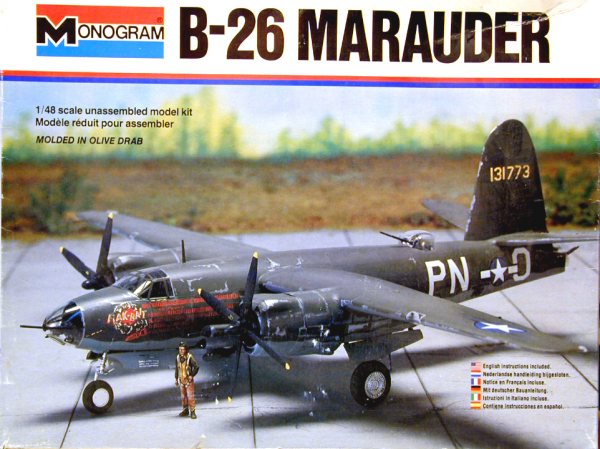
Monogram 1/48 B-26B Marauder
|
KIT # |
5501 |
|
PRICE: |
$6 (in 1978!) |
|
DECALS: |
Two Aircraft |
|
REVIEW & PHOTOS BY: |
|
|
NOTES: |
|

|
HISTORY |

In 1939 the Army Air Corps issued a request for proposals for a high-speed medium bomber. Four months later, the Glenn L. Martin Company submitted its design, an aircraft that would have the highest wing loading of any aircraft designed to that date for the Air Corps, (Note: for you scientific types, wing loading is the gross weight of the aircraft divided by the the area of the wing. In the case of the B-26, this worked out to around 50 lbs. per square foot). The Martin design, designated “Martin 179,” met the required speed of 323 mph, but at the cost of high landing speeds (greater than 100 mph) and long takeoff rolls. The Martin design was ahead of the competition, and in September 1939, the Air Corps issued a contract for 201 aircraft and designated them as B-26s. In keeping with the urgency of the times, 1131 B-26s were eventually ordered before the first prototype ever flew!
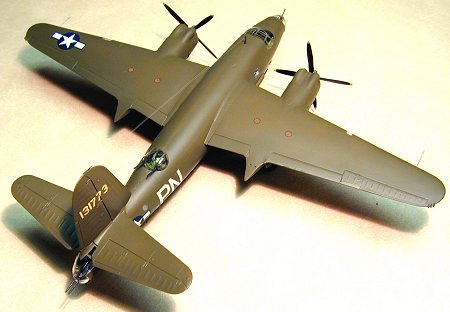 Because it was
difficult to fly, the B-26 got a reputation early on as a “killer,” and the
program was almost cancelled several times. The union of a “hot” airplane with
young, inexperienced aircrews exacerbated the problem. The US Army Air Force (USAAF)
solved these problems by implementing some design changes, including larger
wings and a taller fin and rudder, both to compensate for the larger wing and
improve overall stability, and by introducing additional, advanced training for
crews destined to fly the B-26. Ironically, by the end of the war, the aircraft
- dubbed the “Widow Maker” by those who flew her - would achieve the reputation
as the safest bomber flown by the USAAF in the European Theater. In fact, the
B-26 named “Flak Bait,” which is the subject of this kit (and now enshrined in
the Smithsonian’s National Air and Space Museum), flew more combat missions
(202) than any other US medium bomber of World War II.
Because it was
difficult to fly, the B-26 got a reputation early on as a “killer,” and the
program was almost cancelled several times. The union of a “hot” airplane with
young, inexperienced aircrews exacerbated the problem. The US Army Air Force (USAAF)
solved these problems by implementing some design changes, including larger
wings and a taller fin and rudder, both to compensate for the larger wing and
improve overall stability, and by introducing additional, advanced training for
crews destined to fly the B-26. Ironically, by the end of the war, the aircraft
- dubbed the “Widow Maker” by those who flew her - would achieve the reputation
as the safest bomber flown by the USAAF in the European Theater. In fact, the
B-26 named “Flak Bait,” which is the subject of this kit (and now enshrined in
the Smithsonian’s National Air and Space Museum), flew more combat missions
(202) than any other US medium bomber of World War II.
As delivered, the B-26 had a top speed of 315 mph and a maximum bomb load of 5800 lbs., which was only about 2000 lbs. short of a B-17’s capacity. With the introduction of the longer wing Marauders, the aircraft’s initial armament was augmented by the addition of four “package” .50 cal machine guns, two on each side of the fuselage in a forward firing position, and an additional gun in the nose.
Martin built a total of 5,157 B-26 Marauders, and very few remained in active service after the war, primarily due to the airplane’s production cost (B-25s were about 25% cheaper to produce, so the B-25 production line stayed open longer to build a total of 9,889 aircraft) and its undeserved, early bad reputation.
|
THE KIT |
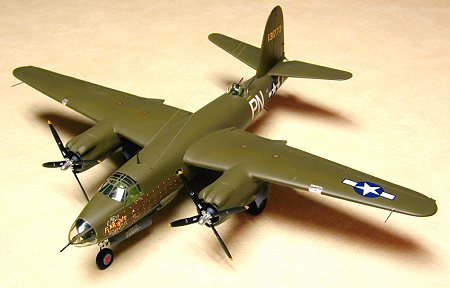 First
introduced in 1978, the Monogram kit is still a pretty good representation of
the prototype. On opening the box, one is greeted by four large sprues of parts
molded in olive drab plastic and one clear plastic sprue of parts. Typical of
the times, the kit has raised panel lines. By today’s standards, interior detail
is somewhat sparse, although for the period it was pretty darn good. The
instructions are also typical Monogram for the times, with step-by-step panels
and paint codes provided for each step. Parts are included for two variations of
the B-26, one of which requires you to modify the shape of the rear gun housing
by removing about 1/2 inch of plastic from the fuselage’s rear tail. Ordnance
includes four 500 lb. bombs eight machine guns plus the four package guns.
First
introduced in 1978, the Monogram kit is still a pretty good representation of
the prototype. On opening the box, one is greeted by four large sprues of parts
molded in olive drab plastic and one clear plastic sprue of parts. Typical of
the times, the kit has raised panel lines. By today’s standards, interior detail
is somewhat sparse, although for the period it was pretty darn good. The
instructions are also typical Monogram for the times, with step-by-step panels
and paint codes provided for each step. Parts are included for two variations of
the B-26, one of which requires you to modify the shape of the rear gun housing
by removing about 1/2 inch of plastic from the fuselage’s rear tail. Ordnance
includes four 500 lb. bombs eight machine guns plus the four package guns.
The decal sheet for kit no. 5501 provides for two aircraft: Flak Bait and a B-26B assigned to the 320th Bomb Group. The blues in the national insignia on the sheet are too light, so I planned to discard these when I got to the decaling stage.
In 1991, Monogram re-released the kit as no. 5506 with different box art and decals. Several years later, Monogram again released the kit, this time molded in gray plastic and including some resin parts such as machine guns and the cockpit (in fact, that is essentially the kit that I built for this review).
|
CONSTRUCTION |
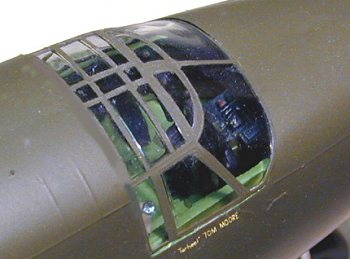 Construction of the kit was straightforward. There were some fit problems,
particularly around the engines, requiring a lot of filling and sanding (my
least favorite aspect of modeling). The fuselage fit also is not the greatest in
the world, particularly on the bottom. Be prepared to spend some time making
things line up and to get smooth transitions between various parts.
Construction of the kit was straightforward. There were some fit problems,
particularly around the engines, requiring a lot of filling and sanding (my
least favorite aspect of modeling). The fuselage fit also is not the greatest in
the world, particularly on the bottom. Be prepared to spend some time making
things line up and to get smooth transitions between various parts.
As usual, I started with the cockpit and essentially assembled it straight out of the box. Once assembled, I painted the interior with Testors chromate green and then painted the various instruments and boxes flat black, picking out the instrument details with white, yellow and red paint.
I opted to
model the aircraft with the bomb bay doors closed, so this eliminated the need
to detail or paint that area. The next step was to install the various pieces in
the fuselage halves before gluing them together. Anybody that has constructed a
WWII bomber knows that one of the touchier assembly areas
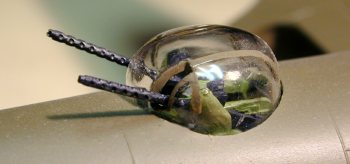 with these kits is gun
turrets, and this one is no exception. The instructions have you paint and
assemble the complete turret and then install it into the right side of the
fuselage. This isn’t a problem until one starts to paint the exterior, and that
lends itself to some tricky masking. Other than Accurate Miniatures’ Avenger,
however, I personally haven’t built a kit to date that was designed to allow the
installation of a gun turret after the fuselage was assembled, so just be
prepared for this.
with these kits is gun
turrets, and this one is no exception. The instructions have you paint and
assemble the complete turret and then install it into the right side of the
fuselage. This isn’t a problem until one starts to paint the exterior, and that
lends itself to some tricky masking. Other than Accurate Miniatures’ Avenger,
however, I personally haven’t built a kit to date that was designed to allow the
installation of a gun turret after the fuselage was assembled, so just be
prepared for this.
The other thing that will require some additional care is the various small windows (6 in all) that must be installed from the inside of the fuselage halves before joining them together. Again, this is primarily a masking problem, but also requires great care so that one does not scratch any of these windows during subsequent sanding of the exterior seams.
 There are
two bulkheads that one installs to form the bomb bay, and these also have large
spars on them that stick through the fuselage halves to support the wings. I
also installed the cockpit into the right fuselage half. The model will be tail
heavy, so plan on installing weights if you want it to sit properly on its
tricycle landing gear. These can go in the bomb bay if you model it closed, or
in the engine nacelles (the nose area is limited due to the glass nose and the
wheel well).
There are
two bulkheads that one installs to form the bomb bay, and these also have large
spars on them that stick through the fuselage halves to support the wings. I
also installed the cockpit into the right fuselage half. The model will be tail
heavy, so plan on installing weights if you want it to sit properly on its
tricycle landing gear. These can go in the bomb bay if you model it closed, or
in the engine nacelles (the nose area is limited due to the glass nose and the
wheel well).
Next, I assembled the engines and painted them prior to installing them into the cowlings. I glued the wings together and then attached these to the fuselage. The engines and cowlings were then glued to the wings, and then I entered the next fit problem area: the carburetor intakes and the aerodynamically flared ends of the engines. Both of these areas required careful fitting, and then a lot of putty and sanding to get acceptable seams.
I attached the canopy onto the fuselage with white glue and then filled the seams for a tight fit. I opted to leave off the glass nose to avoid the need for complicated masking around the guns. The model was then ready for the paint shop.
|
PAINT & DECALS |
Ever since
I saw the nose section of Flak Bait on display in the Air and Space
Museum in 1977, the aircraft and its history have intrigued me. Coupled with the
fact that one of my good friends was a B-26 pilot during WWII, I decided that I
would model Flak Bait and give it to him as a present (I haven’t made the
presentation yet, but it will happen soon!). Given my relatively cheap nature, I
decided to use the kit decals rather than purchase the Aeromaster sheet (no.
48-413, which is currently unavailable). Unfortunately, anyone familiar with
Monogram decals of the seventies knows the problems they had (in short, they
were dog-poopie!!). Nevertheless, I was determined to
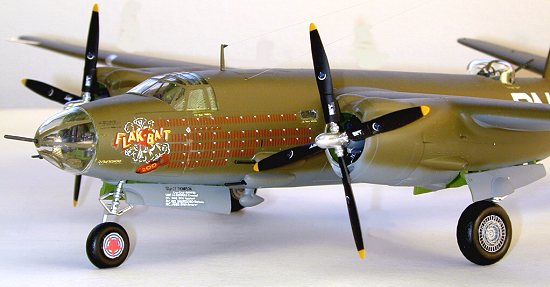 use them, so I pressed
ahead. Having already decided that the blues in the national insignia were too
light, I opted to use the national insignia from the later Monogram kit (the one
with resin parts), which are spot on.
use them, so I pressed
ahead. Having already decided that the blues in the national insignia were too
light, I opted to use the national insignia from the later Monogram kit (the one
with resin parts), which are spot on.
Prior to painting, all of the glass surfaces were masked using Scotch brand magic tape. This takes a while, given the cockpit glass and the various observation windows throughout the aircraft. Once these were masked, the wheel wells were sprayed with Testors chromate green, and then stuffed with wet Kleenex. I then sprayed the model overall with Aeromaster neutral gray. Next, I painted the topside surfaces Aeromaster Olive drab, and except for the demarcation line along the engines, I freehanded this paint job to create a softer transition look between the upper and lower surfaces.
Once the paint had dried, I shot a coat of Future floor polish over all the kit (and this kit has a lot of surface area!). Once dry, I applied the decals. As usual, I had a tough time making the older Monogram decals snuggle down, but a really glossy surface and decal solvent solutions helped.
During the decaling process, I screwed up the red star decal for the nose wheel, so, not wanting to rip into another kit just for that decal, I got out my trusty old Adobe Illustrator software and recreated another one on paper. I then cut this out and glued it to the wheel hub (fortunately, this doesn’t have to snuggle down as there is a good transition between the tire and wheel rim).
Once the decals were dry, I shot the model with Testors Dullcote to take the shine off it. Lastly, I attached the wing pitot tubes, the landing gear and the landing gear doors to the model. I slightly flattened the tires using an Exacto knife to give the model that used look. I then attached the glass nose, which had been separately masked and painted. Finally, I made an antenna out of stretched sprue and attached it to the fuselage and tail using white glue.
|
CONCLUSIONS |
As far as I know, this is the only injection-molded 1/48th scale kit of the Marauder. Therefore, if you want to build one in this scale, this is it. Given its age, it still builds into a very good representation of the prototype. I enjoyed building the kit, and have several more unbuilt kits in my collection. I recommend it to anyone who doesn’t mind filling and sanding seams, and can live with the raised panel detail. It is an impressive model to add to one’s collection or to present to a friend!
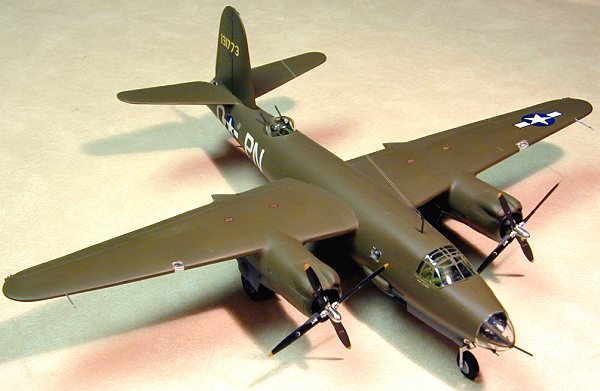
|
REFERENCES |
1. Birdsall, Steve, “B-26 Marauder in Action,” Squadron/Signal Publications, 1981.
2. Scutts, Jerry, “B-26 Marauder Units of the Eight and Ninth Air Forces,” Osprey Publishing, 1997.
3. “B26.com”, http://www.b26.com, website, 2001.
Copyright ModelingMadness.com
If you would like your product reviewed fairly and fairly quickly, pleasecontact the editor or see other details in the Note to Contributors.